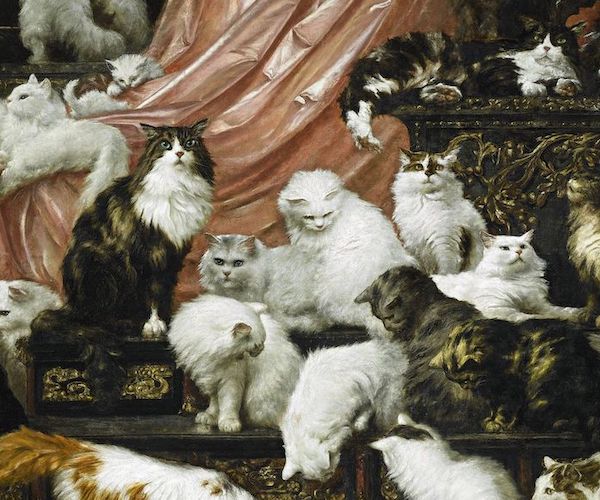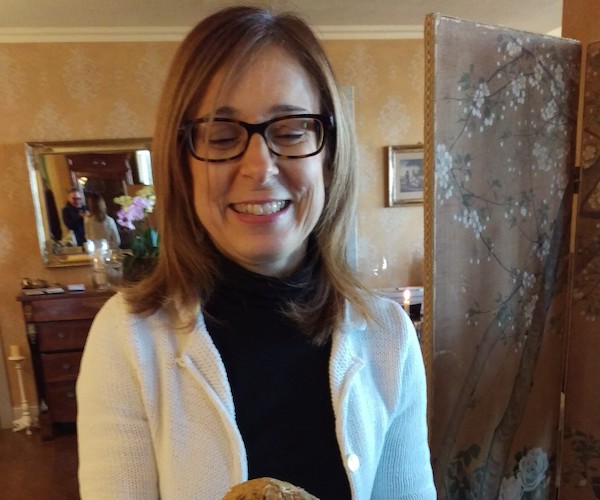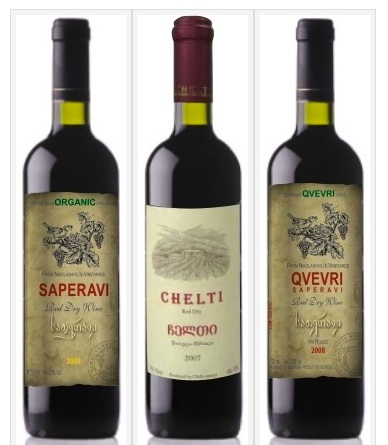Lorette C. Luzajic mourns the loss of her feline friend and says, ‘lets’ drink to cats’…
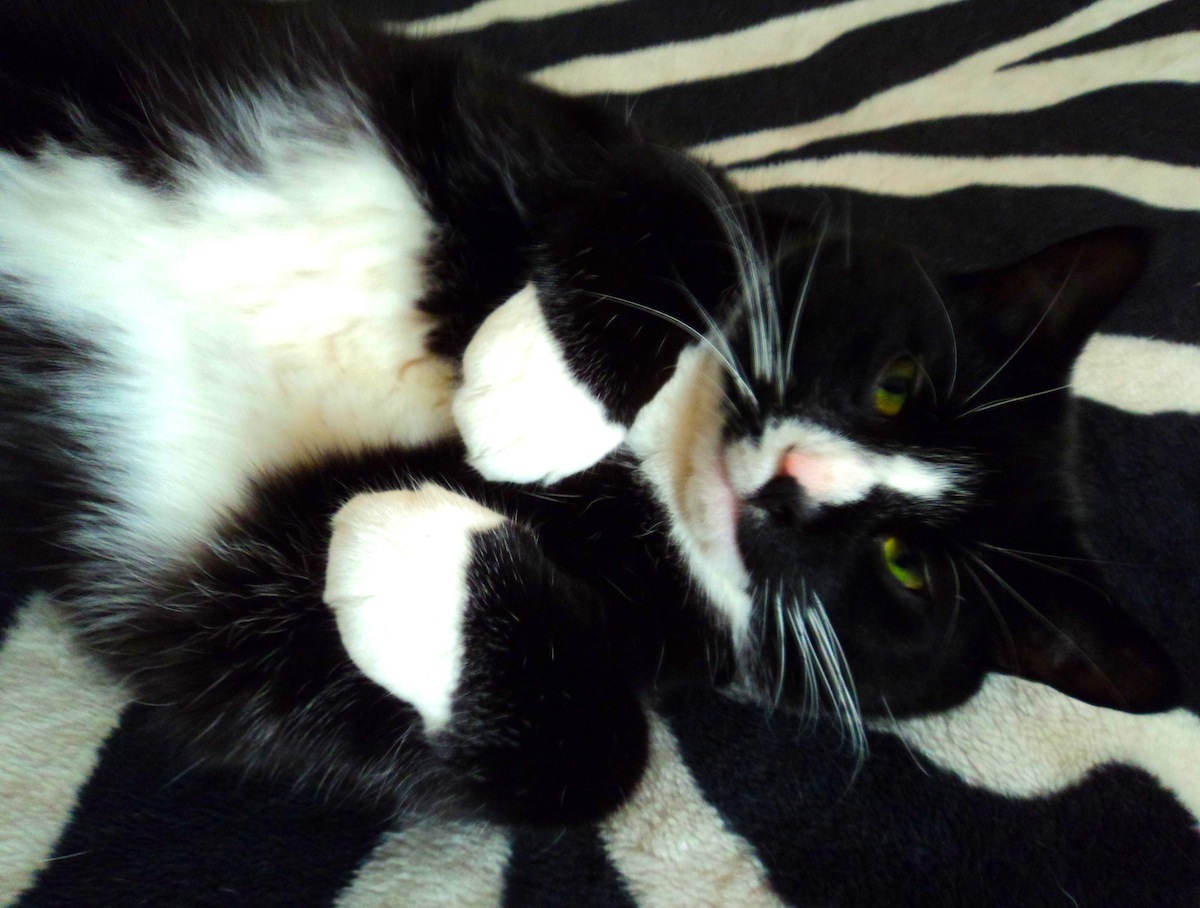
The first swallow was a wallop of bad medicine and prunes- a good reminder to always aerate before the initial swill.
By the third mouthful, I was more convinced that The Magic Box’s Amazing Cabernet was what it claimed to be. The second sip was a heady cluster of coffee and violets, and the next was light and powdery, trailing smoke.
My expectations of what’s in a bottle aren’t usually so demanding. When it comes to wine, I like everything. Even a take it or leave it model tends in my taste towards “take it.” But one week into the hopeless misery I’d been plunged into by the unexpected departure of my darling tuxedo feline, I wanted something thick and silky like that coat, something that would conjure his purr.
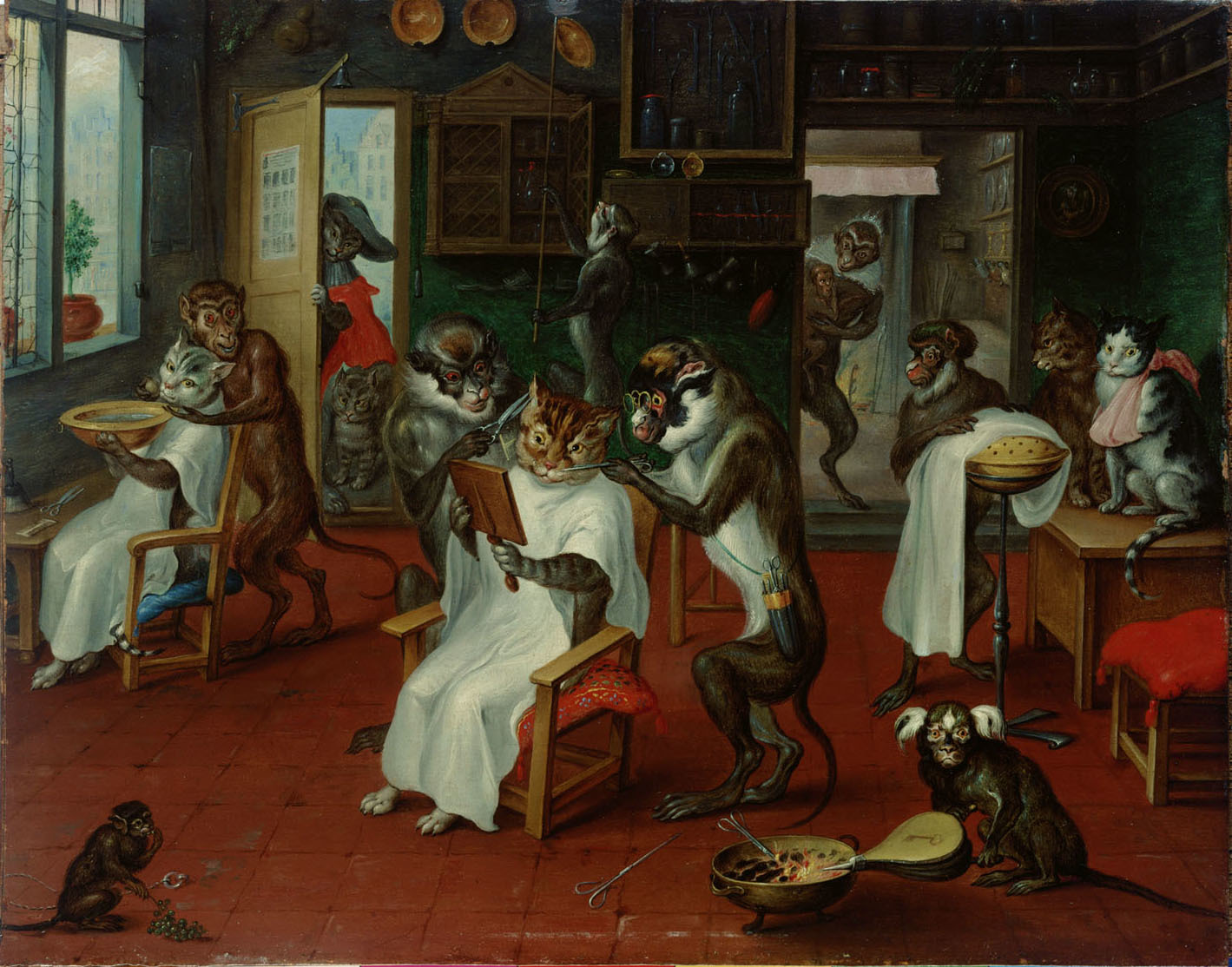
The story of cats is a long and juicy one. That cats are a profound muse to humanity is a matter of record in science, religion, psychology and medicine. There’s a treasure trove of folk legends, mythology, mystery, worship, and poetry on the subject, and the masses don’t get left out of the picture, either. Who doesn’t love a lolcat? Who can’t name ten iconic TV or comic cats, or turn up thirty different cat books in their kid’s library?
Cats strike a dozen chords at once. They have a mind of their own, always secure in their own idiosyncrasies, and seldom soliciting approval. They reign the roost on their own terms. The old adage is that you don’t have a cat, the cat has you. Anyone who gets that will be rewarded beyond their wildest measures for the chance to serve a creature of this sort.
And they are funny. For all their royal genes, cats are more campy than narcissist- they don’t take themselves too seriously if you’re in on the joke.
They are wildly beautiful. Even the most absurd specimen is elegance personified. The most ruffian brute from the alley has an admirable carriage. The cat’s eye is a symbol of legend transcending cultures and millennia. Her curves and plumes and colours in all their manifestations are breathtaking. Few of God’s creatures are as blessed by beauty- horses, maybe, or the moon, and a few birds.
Bertie was a magnificent animal, a glorious 24 solid gold pounds of hefty cat and sumptuous black and white fur. He was an enormous alpha but he gave himself like a baby. He loved to fan out, belly up, on my desk beside my keyboard as if it was a Scrabble board and not my workplace. He was longer and wider than the desk itself, and his paws were like the wrists of a small child, but still he never once knocked over a wine glass or pencil with that swishing tail.
I have mourned a husband and a father, and not sure anything could cut as deep save the loss of a child. But it is the loss of my cats that always left me the most pathetic and messy. The end of a cat is the end of an era. It is a gear shift that has left me in pieces, bottle in hand, pouring over Instagram cats and rescue profiles online, looking for my next fix.
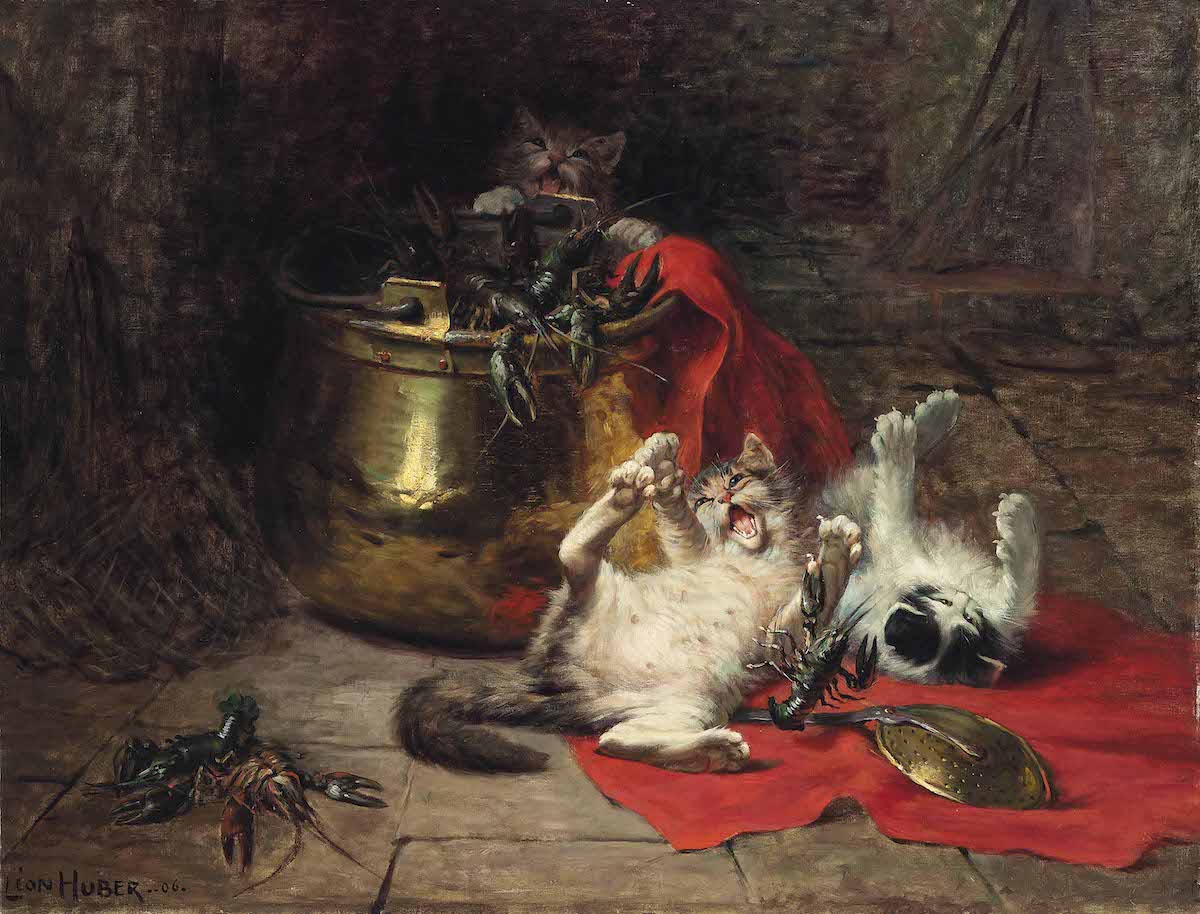
This is how I came across the saccharine brush of Leon Charles Huber, who spent the early nineteenth century painting Hallmarkable feline whimsies. His gushing oversentimentality towards his subject couldn’t overshadow his technical prowess. He is as adept as any still life master, only these aren’t still. Wriggling kittens, with thread-fine hair textures, and rows of tiny sharp teeth, ululate, and knead the air, beside glittering brass jugs. It was a badge of honour among still life painters to show off their skills capturing metallic and glass lights and textures of fruit and fabric. It takes an exceeding amount of talent and technique to render soft or silver or smooth surfaces in a few pigments and some oil. Painters then did not have access to a variety of materials or colours, and to those of us who do, today, few still can recreate a bronze pitcher, or a cat.
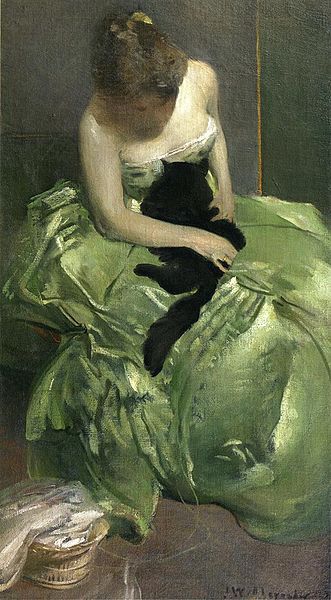 John White Alexander was a portraitist who immortalized a few ladies of leisure in their voluptuous dresses. The Pittsburgh orphan was as talented as his peers Whistler and Sargeant but like most who live and die, he has nearly dissipated into oblivion. And that cold truth might seal his fate, except for that painting that keeps surfacing here and there, the one of the coquette in apple green taffeta, with her jet black familiar contrasting the dance of Granny Smith satin and luminous skin.
John White Alexander was a portraitist who immortalized a few ladies of leisure in their voluptuous dresses. The Pittsburgh orphan was as talented as his peers Whistler and Sargeant but like most who live and die, he has nearly dissipated into oblivion. And that cold truth might seal his fate, except for that painting that keeps surfacing here and there, the one of the coquette in apple green taffeta, with her jet black familiar contrasting the dance of Granny Smith satin and luminous skin.
Seventeenth century Belgian painter Abraham Tenniers (see the second picture above) is remembered as a genre painter- although what genre he was painting is a matter for a little confusion. He was fond of peasants. But he also painted a great many monkeys…. and cats. He beat the surrealists by three hundred years, populating barber and salon tableaus with simian servants to friendly felines.
Underrated American surrealist Gertrude Abercrombie’s paintings had a perpetually naivety, flat, simple colour-blocked depictions that felt like lucid dreams. They borrowed qualities from Magritte, storybooks, and the interiors genres, and drew from psychological analysis and symbolism. Lots of eggs and windows and blindfolds and mirrors, lots of picture frames and ladders and naked trees. And always a cat lurking around the corner.
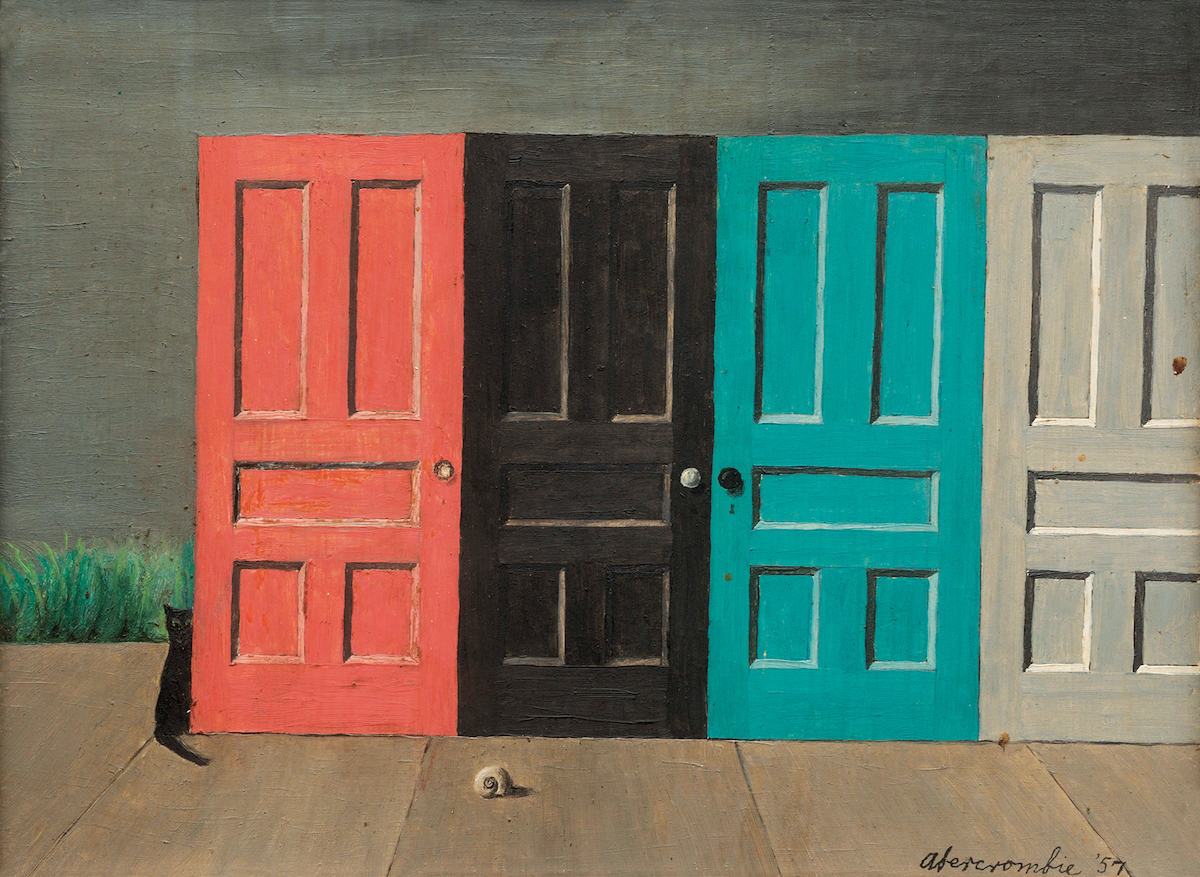
A personal favourite is Four Doors, Cat from 1957. The piece shows four coloured doors, red, black, teal and white, behind a shell, with a small black cat stationed on the left. Gertrude had several more in this vein, changing the red door to gray, positioning the cat front and centre instead.
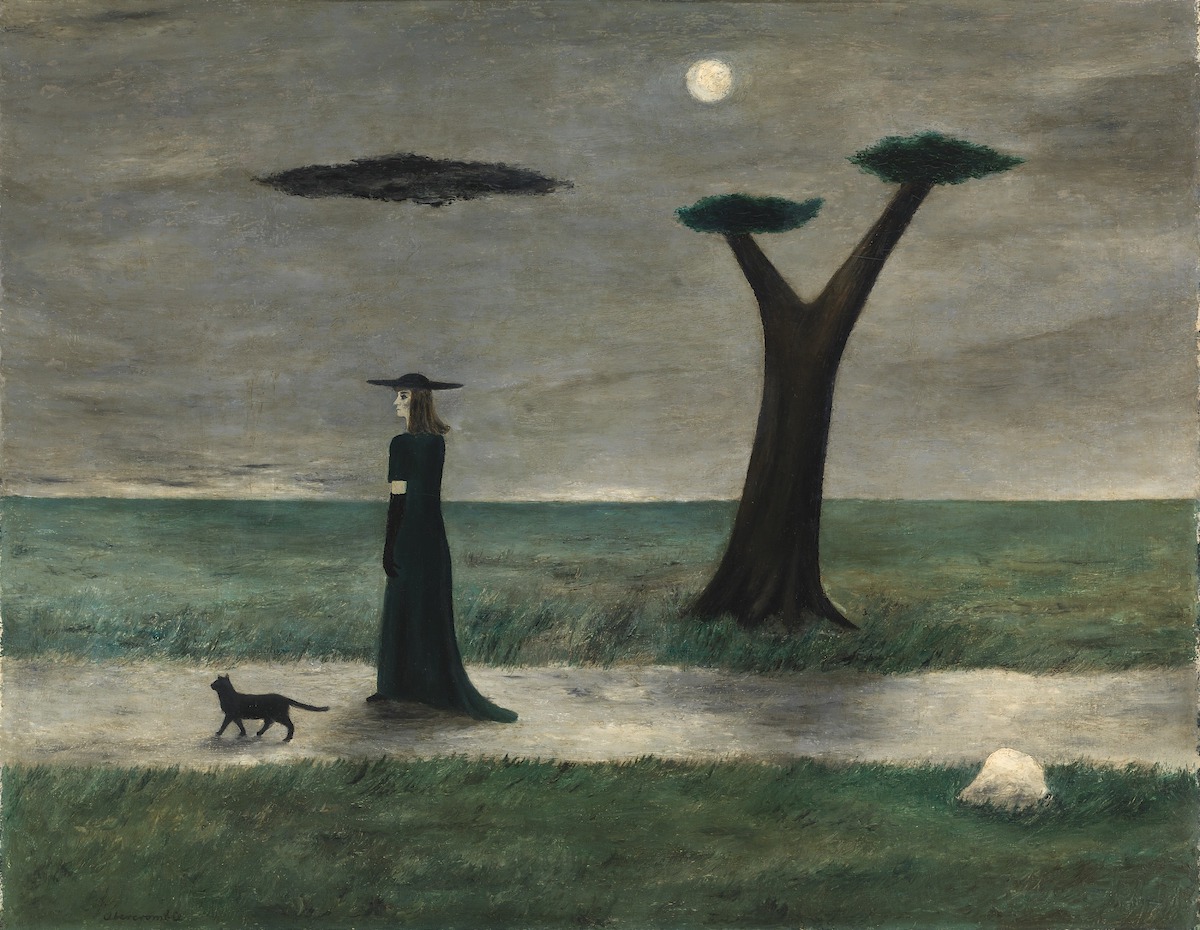
Direct capture
In another work, a woman sits on a head-shrink style chaise lounge, with a white cat keeping vigil. In still another, a mysterious female figure draped in blue points at a black cat under a picture of a black cat. Perhaps her most famous cat painting is The Stroll, a self portrait as the lady in black, walking with her cat.

There are countless others. The cat has been muse to many. Picasso was a bull of a man humbled by nothing- but we can all witness his humility before his gentle rival, the only beast more epic than he was. And Swiss sculptor Alberto Giacometti, best known for skinny stick figures in bronze, was enchanted by his brother’s cat, an animal that manifest the lithe and lanky attributes of his artwork.

Of course, the greatest of all cat paintings is the million-dollar masterpiece by Carl Kahler, who narrowly skirted that abyss of obscurity because a millionaire patron was a crazy cat lady of epic proportions.
Poor Kahler is immortalized by this lone luscious tribute to forty-two of her felines. The work became known as My Wife’s Lovers and spurred legends of the great dame’s fictional 350 cats and alleged bequests to them after her departure. The painting was larger than life, making her prized Persians and Turkish longhairs unrealistically massive and taking up a whole room. The artist was in demand ever after, permanently a slave to painting green eyes and whiskers.
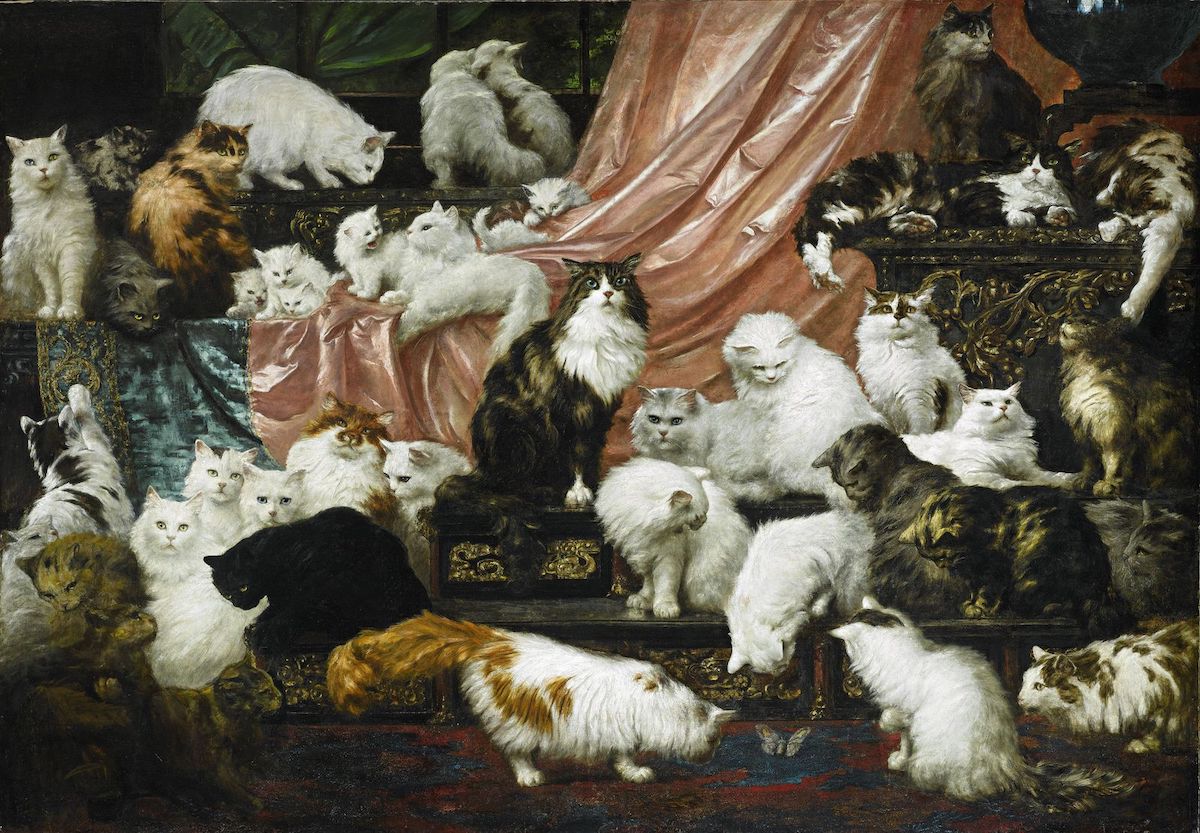
The story of domesticated cats is fittingly shrouded in mystery, with gold-ringed half-female, half-feline goddesses reigning over vast cat mummy cemeteries in ancient Egypt. For this reason, we have long estimated cat domestication and fascination at around five millennia, but older remains found further afield have now doubled our timeline. Cyprus has unearthed pets buried with their humans ten thousand years back. Historians reasoned that cats became sacred when they scavenged snakes that endangered the rich and the gods, and no matter where that happened in the historical chronology, it’s likely an essential clue to our relationship. Cats were welcomed saviors on ships and in granaries, eliminating rodents that carried all manner of plagues and scourges.
Of course, cats were alternately feared, not worshiped. In medieval artwork and manuscripts, they look more like demons than goddesses. The misunderstood beasts were accused alongside women and homosexuals with witchcraft. They were suspected shape shifters, the devil incarnate walking the earth. The condemnation was short-lived whenever rats overran the streets- then the cruel hunters were lured back to secure the salvation of the city.
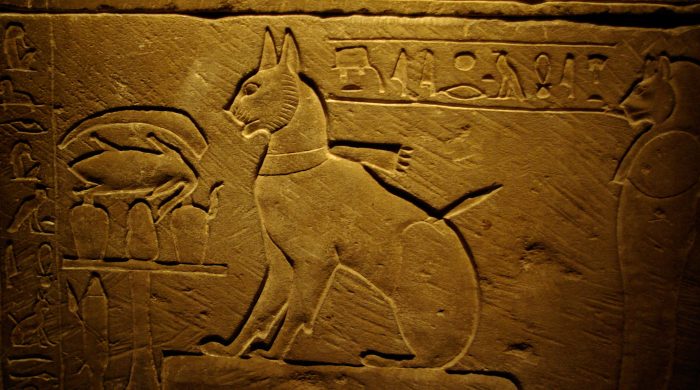
The love-hate hysteria with cats persists still to this day. And modern fear of cat poo and the elusive nature of the independent introvert could hold the clues to the long disdain that ran parallel with worship and obsession. A poisonous bacteria in cat feces is a suspected cause in some psychoses resembling schizophrenia. The same reason why pregnant women and immune-compromised folks are ordered to stay away from cat litter might hold the key to some of the strange effects of cats on personality. Though vets decry irrational hatred and abuse of innocent animals, and point out that practical handling and hand washing is all that’s required to avoid the brain parasite infecting feline waste, the t. gondii brain parasite that causes toxoplasmosis is present in a large minority of cats. It is shed in the lovely sounding oocysts- stringy bacteria-riddled eggs in cat feces. The erratic behavior of all those women cavorting with the devil the middle ages may have had physiological reasons linked to the deplorable hygiene of the era. The hallucinatory rye ergot and bread fungi and the mind-bending diseases festering in fish and foliage were only half the story.
The paradox of cats has always been that for all their perils and pitfalls, they simply make life better. It’s a familiar story to those of us who also love booze.
Four more wines to have on hand for when your cat dies:
Moselland, German Riesling
The wine bottle that everyone saves- the cat bottle. Only twelve bucks. The entire twelve is really just for the bottle, but still. No one can drink that much sugar, even in a German Riesling. But you can fill the vessel with anything you want forever after.
Cat’s Pee on a Gooseberry Bush- Sauvignon Blanc
The chance anyone might still pull this one out of the cellar is slimmer than a kitten’s whisker. But the noughties’ New Zealand Cooper’s Creek recipe is still famous for its sense of humour. Sommeliers and armchair enthusiasts alike will seldom describe wine’s library of taste sensations with scatological terms or references to bodily fluids, but once in awhile you’ll hear someone praise Sauvignon Blanc for flavours like “cat pee.”
Others will use euphemisms like “vegetal” but I always like to tell it like it is. There are pyrazines in some white wines, stuff that makes you think of mushy asparagus or rancid cat piss, but in a good way.
I like a bracing Sauvignon Blanc as much as the next person, but if toasting Simba or Cleo with Cat’s Pee makes you cringe, say something about “fresh cut grass.”
Louis Jadot Beaujolais- Villages
Ah, yes, mouthfuls of fresh berries and ice cream aromas. Pippa’s ghost might demand the easy drinking Beaujolais. Mourn in rhyme with dancing or old movies. I suggest cranking this girl open while the feline’s still alive, turning a good sipping session into a bonding lullaby instead of a goodbye. If there’s still time, celebrate with an $18 steal. Not too extravagant, not too frugal, an occasion for joy mixed with solemn contemplation of closure to come.
Mateus, Duchess of Portugal
Sentimental times call for sentimental wines. If this is the wine you got wasted on with your mother when you were barely legal, perhaps the oldest rosé on the shelves still has a special purpose to serve.
Rosé is funerary wine, whether it’s Bella under the lilac tree or something the newly nineteen kids can drink to drown the egg salad triangles at Oma’s. It’s been known for years as “starter wine” or the “gateway drug,” helping to lubricate newbies into wine and wean them off of Peach Schnapps.
I can’t in good conscience crack this one open often, but sometimes when a good cry is coming, it’s the only thing that’s real.
Browse through all of Lorette C. Luzajic’s GFR Series ‘Wine and Art’ here. – Ed

